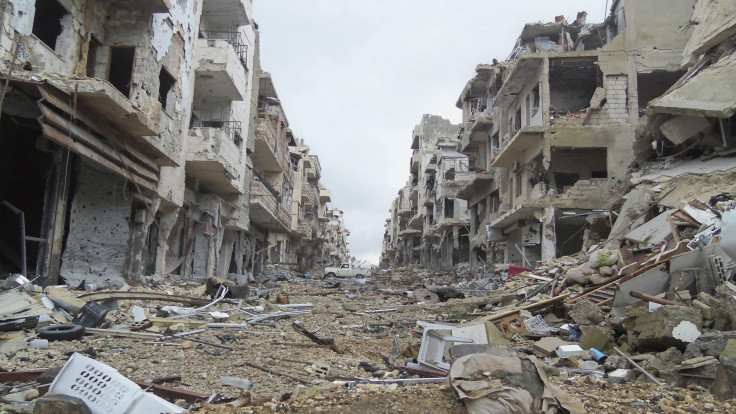After Homs Retreat, Outgunned Syrian Opposition Pushes For Heavier Weapons

The streets of the Jouret al-Shayah neighborhood in the beleaguered city of Homs, Syria, are cluttered with pieces of broken furniture, tables, chairs and old TV sets thrown from the homes they used to decorate before intense fighting ravaged the city. Opposition forces in the city managed to stave off the military for years, setting up sniper posts in the crumbling buildings and using rocket-propelled grenades to target tanks. But as the war dragged on and international aid teetered, the opposition began to lose grip of the city it dubbed the “capital of the revolution.”
Rebel forces pulled out of Homs on Wednesday after an almost two-year siege, in a deal between opposition leaders that military officials made on May 2. The deal gave control of the city to the government and allowed for the rebels’ safe evacuation. The withdrawal from the city, while not disastrous strategically for the opposition, underscores why now, more than ever, it needs weapons that will give it a fighting chance against the military’s firepower.
Rebels had been unable to get weapons to flow into the city during the siege. But even if they had managed to acquire more weapons from other areas of Syria or had bought them from groups in Turkey, their choices would have been limited to light weaponry such as Kalashnikovs, other rifles or grenades. The fight between the opposition and military forces was never even. President Bashar al-Assad’s army had one tool the rebels didn’t: airplanes.
This week, Ahmad al-Jarba, president of Syria's main opposition bloc, is in Washington asking the U.S. government for anti-aircraft missiles, which would neutralize the regime’s main advantage.
This request, though timely given the rebel withdrawal from Homs, is not new. The rebels have been asking for international donors to provide anti-aircraft missiles for years. Last summer, President Obama announced that the U.S. would send arms to specific factions of the Free Syrian Army (FSA) through a CIA-led program, but that program did not include anti-aircraft missiles. The U.S. and Saudi Arabia have been hesitant to provide them because of the risk that they could fall into the wrong hands -- which is exactly what happened in Afghanistan in the 1980s in the fight against the Soviet Union, when American Stinger missiles shipped to local mujahideen later ended up in the arsenal of anti-Western groups.
Abu Ahmed, a former regime military commander in Damascus who defected to the insurgency, now works in Reyhanli, Turkey, collecting weapons and supplies for rebels inside Syria. Although he works for Brig. Gen. Abdul-Ilah al-Bashir, the leader of the FSA, he says he does not know the origin of the weapons he distributes.
The competition for resources among rebels in Turkey has reached a new level. Rebels are shifting their alliances and using their own methods to purchase weapons; for example, by kidnapping for ransom and buying arms from the Syrian military.
Fighters are also switching groups, and their weapons follow them. After the Supreme Military Council of the rebels sacked Gen. Salim Idris in February and brought on Bashir, rebels say the chain of command completely broke down. Even before the shakeup in the council, rebels associated with the FSA used southeastern Turkey as a base for building up their battalions, buying weapons and recruiting soldiers. The infighting among rebel groups has only intensified since.
Such shifting alliances threaten the success of the U.S. mission to arm rebels in Syria. The Obama administration does not want the arms to fall into the hands of the “wrong” opposition soldiers. It defined Jabhat al-Nusra as a terrorist organization and a group that it wants to keep from attaining U.S. arms. But with loyalties constantly changing among opposition groups inside Syria and with the increasing bartering activity, there is little evidence that the weapons the U.S. sends to the opposition will make it to the intended recipients. And with the growing influence of extremist factions such as the Islamic State of Iraq and the Levant (ISIS), there is a greater chance that the weapons will not make it to areas of Syria that had previously been dominated by FSA forces.
Al Bab, a city 30 miles (50 km) northeast of Aleppo, is one of those places. The city had been liberated from military control by battalions associated with the FSA in August of 2012 but it is now under ISIS rule. As a result of the infiltration, the military has begun dropping barrel bombs on the city, killing dozens of people with each attack.
There is not only a risk that weapons will be intercepted inside of Syria, but there is also a chance that because of the escalating war between opposition groups in Turkey, the weapons will be traded and bartered before entering Syria.
Despite increased shipments of weapons from the U.S. and Saudi Arabia, the antitank missiles and heavy armor are bypassing those groups who need them the most.
“Most of the U.S. weapons are coming into Turkey from the seaports and airports. Then they are transferred with the security of the Turkish government to the chiefs of staff of the Free Syrian Army,” Abu Ahmed said. “But only certain weapons actually make it into Syria.”
© Copyright IBTimes 2024. All rights reserved.




















